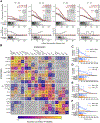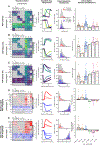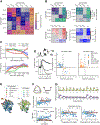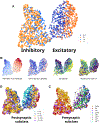Local connectivity and synaptic dynamics in mouse and human neocortex
- PMID: 35271334
- PMCID: PMC9970277
- DOI: 10.1126/science.abj5861
Local connectivity and synaptic dynamics in mouse and human neocortex
Abstract
We present a unique, extensive, and open synaptic physiology analysis platform and dataset. Through its application, we reveal principles that relate cell type to synaptic properties and intralaminar circuit organization in the mouse and human cortex. The dynamics of excitatory synapses align with the postsynaptic cell subclass, whereas inhibitory synapse dynamics partly align with presynaptic cell subclass but with considerable overlap. Synaptic properties are heterogeneous in most subclass-to-subclass connections. The two main axes of heterogeneity are strength and variability. Cell subclasses divide along the variability axis, whereas the strength axis accounts for substantial heterogeneity within the subclass. In the human cortex, excitatory-to-excitatory synaptic dynamics are distinct from those in the mouse cortex and vary with depth across layers 2 and 3.
Conflict of interest statement
Figures







Similar articles
-
Quantal analysis reveals a functional correlation between presynaptic and postsynaptic efficacy in excitatory connections from rat neocortex.J Neurosci. 2010 Jan 27;30(4):1441-51. doi: 10.1523/JNEUROSCI.3244-09.2010. J Neurosci. 2010. PMID: 20107071 Free PMC article.
-
Primary visual cortex shows laminar-specific and balanced circuit organization of excitatory and inhibitory synaptic connectivity.J Physiol. 2016 Apr 1;594(7):1891-910. doi: 10.1113/JP271891. Epub 2016 Mar 11. J Physiol. 2016. PMID: 26844927 Free PMC article.
-
Synaptic connectivity to L2/3 of primary visual cortex measured by two-photon optogenetic stimulation.Elife. 2022 Jan 21;11:e71103. doi: 10.7554/eLife.71103. Elife. 2022. PMID: 35060903 Free PMC article.
-
Salient features of synaptic organisation in the cerebral cortex.Brain Res Brain Res Rev. 1998 May;26(2-3):113-35. doi: 10.1016/s0165-0173(97)00061-1. Brain Res Brain Res Rev. 1998. PMID: 9651498 Review.
-
Developmental alterations in the functional properties of excitatory neocortical synapses.J Physiol. 2009 May 1;587(Pt 9):1889-96. doi: 10.1113/jphysiol.2009.169458. Epub 2009 Mar 9. J Physiol. 2009. PMID: 19273572 Free PMC article. Review.
Cited by
-
State modulation in spatial networks with three interneuron subtypes.bioRxiv [Preprint]. 2024 Aug 24:2024.08.23.609417. doi: 10.1101/2024.08.23.609417. bioRxiv. 2024. PMID: 39229194 Free PMC article. Preprint.
-
Multimodal Nature of the Single-cell Primate Brain Atlas: Morphology, Transcriptome, Electrophysiology, and Connectivity.Neurosci Bull. 2024 Apr;40(4):517-532. doi: 10.1007/s12264-023-01160-4. Epub 2024 Jan 9. Neurosci Bull. 2024. PMID: 38194157 Free PMC article. Review.
-
HCN channels at the cell soma ensure the rapid electrical reactivity of fast-spiking interneurons in human neocortex.PLoS Biol. 2023 Feb 6;21(2):e3002001. doi: 10.1371/journal.pbio.3002001. eCollection 2023 Feb. PLoS Biol. 2023. PMID: 36745683 Free PMC article.
-
Cortical interneurons: fit for function and fit to function? Evidence from development and evolution.Front Neural Circuits. 2023 May 4;17:1172464. doi: 10.3389/fncir.2023.1172464. eCollection 2023. Front Neural Circuits. 2023. PMID: 37215503 Free PMC article. Review.
-
The proteomic landscape of synaptic diversity across brain regions and cell types.Cell. 2023 Nov 22;186(24):5411-5427.e23. doi: 10.1016/j.cell.2023.09.028. Epub 2023 Nov 1. Cell. 2023. PMID: 37918396 Free PMC article.
References
-
- Thomson AM, Bannister AP, Interlaminar Connections in the Neocortex. Cereb Cortex. 13, 5–14 (2003). - PubMed
-
- Markram H, Toledo-Rodriguez M, Wang Y, Gupta A, Silberberg G, Wu C, Interneurons of the neocortical inhibitory system. Nat Rev Neurosci. 5, 793–807 (2004). - PubMed
-
- Douglas RJ, Martin KAC, Neuronal circuits of the neocortex. Neuroscience. 27, 419–451 (2004). - PubMed
Publication types
MeSH terms
Grants and funding
LinkOut - more resources
Full Text Sources
Molecular Biology Databases

